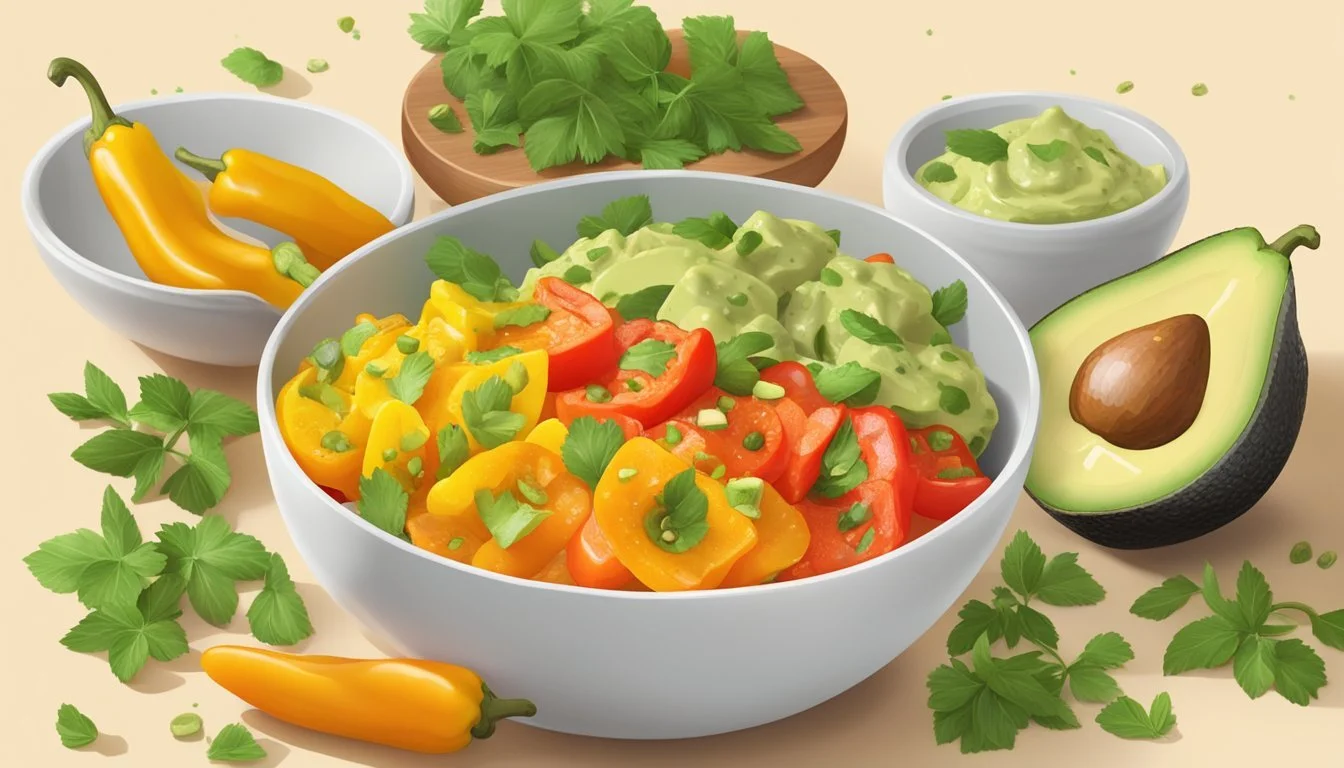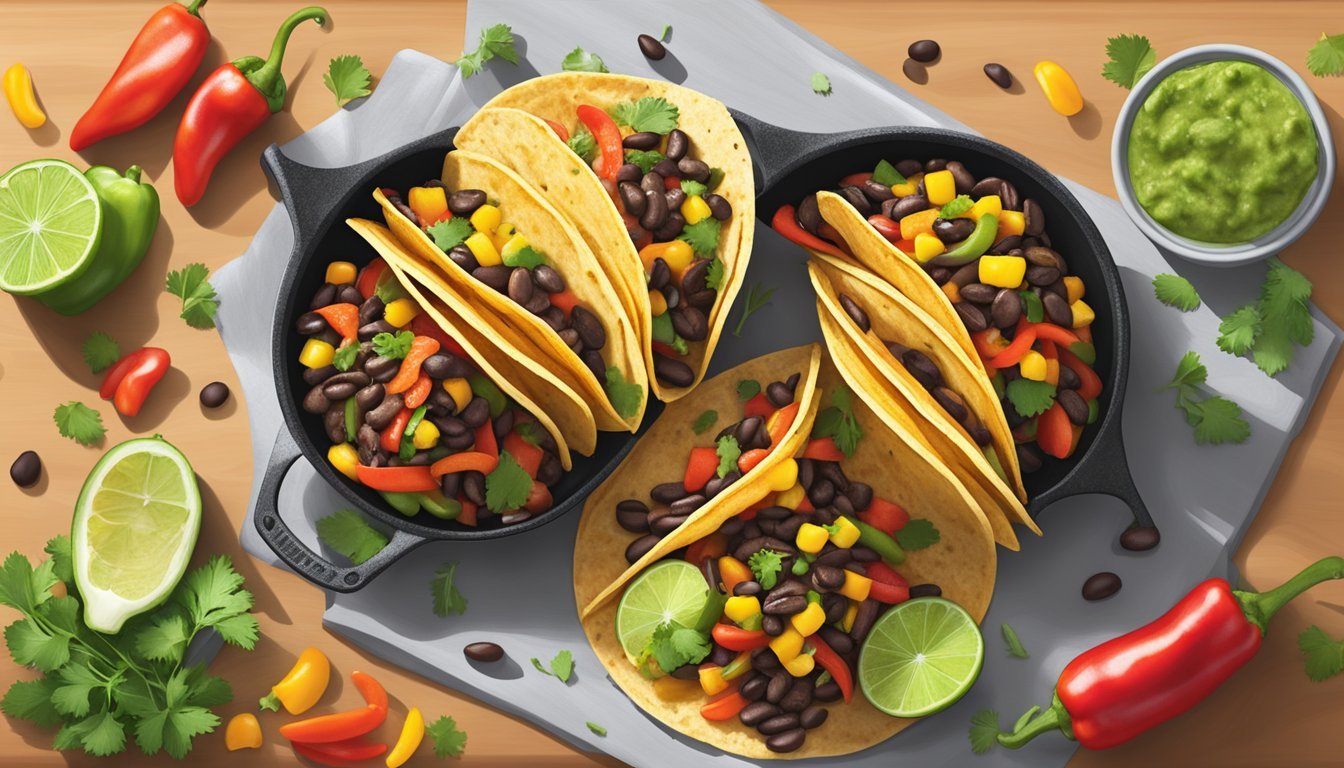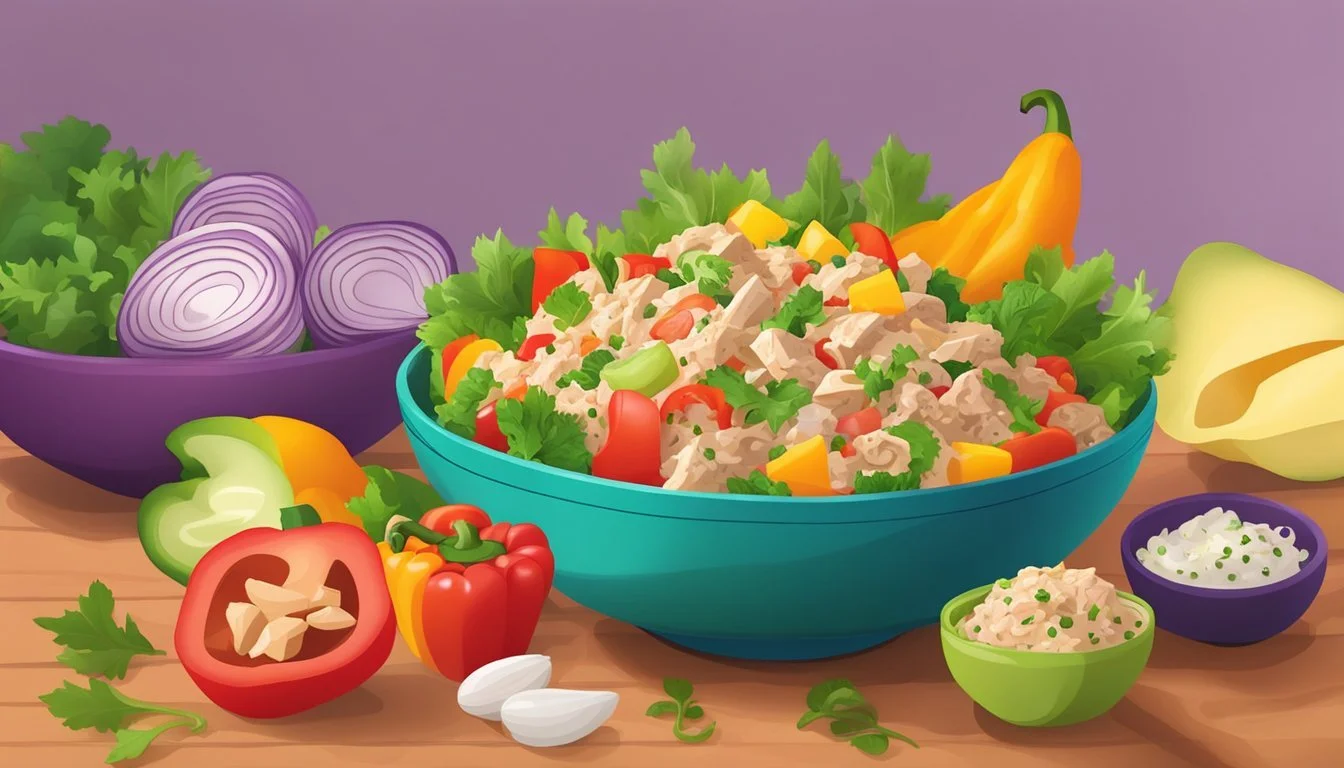10 Delicious Diabetes-Friendly Recipes Using Bell Peppers for Healthy Meals
Bell peppers stand out not only for their vibrant colors but also for their impressive nutritional profile, making them an excellent choice for those managing diabetes. Packed with vitamins, antioxidants, and fiber, bell peppers can be seamlessly integrated into a variety of dishes that are both delicious and health-conscious.
This article explores 10 diabetes-friendly recipes that highlight the versatility of bell peppers in creating nutritious and flavorful meals. Each recipe is designed with a focus on maintaining low carbohydrate levels while maximizing taste, making these dishes suitable options for those aiming to regulate their blood sugar levels without compromising on flavor.
1) Stuffed Bell Peppers with Quinoa
Stuffed bell peppers with quinoa offer a tasty and diabetes-friendly option. These colorful peppers are filled with nutrient-rich quinoa and seasonal vegetables.
Start by preheating the oven to 375 degrees F. Half and de-seed the bell peppers. Lightly grease a baking dish and place the peppers cut-side up.
In a large mixing bowl, combine cooked quinoa with corn, black beans, diced tomatoes, green chiles, and a dash of cumin and chili powder. Season with salt and pepper.
Fill each pepper half with the quinoa mixture. For an extra touch, top with grated cheese. Bake for about 25-30 minutes, until the peppers are tender and the cheese is melted.
Once ready, remove from the oven and let cool slightly before serving. This dish pairs well with a fresh green salad or steamed vegetables. These stuffed peppers are not only delicious but also packed with protein and fiber, making them a great addition to a diabetes-friendly meal plan.
2) Bell Pepper Chicken Stir-Fry
Bell Pepper Chicken Stir-Fry combines vibrant flavors and textures, making it a favorite for diabetes-friendly meals. This dish features bell peppers, which add a splash of color and a healthy dose of vitamins.
To prepare, start by heating a bit of oil in a large skillet or wok. Add cut pieces of chicken, stirring frequently until they are browned and cooked through.
Next, add sliced bell peppers to the skillet. Include varieties like red, yellow, and green to make the dish visually appealing. Stir-fry the peppers for a few minutes until they begin to soften.
For additional flavor, garlic and ginger are excellent choices. Minced garlic and grated ginger should go into the skillet right after the bell peppers. Stir them well to coat the chicken and vegetables.
A simple sauce can bring everything together. Combine soy sauce, a touch of honey, and a splash of rice vinegar. Pour this sauce into the skillet, letting it simmer until it slightly thickens and coats the ingredients nicely.
Serve the Bell Pepper Chicken Stir-Fry hot, and enjoy a meal that's both nutritious and delicious. This dish pairs well with brown rice or quinoa for a complete, balanced meal.
3) Bell Pepper and Avocado Salad
Bell Pepper and Avocado Salad is a refreshing and nutritious option for those with diabetes. Bell peppers provide a vibrant crunch and are low in carbohydrates, making them ideal for maintaining stable blood sugar levels.
This salad combines diced bell peppers with ripe avocado, adding a creamy texture and healthy fats. Avocado is rich in monounsaturated fats, which can help manage blood sugar levels.
Other ingredients that can enhance the flavor and nutritional value include cherry tomatoes, green onions, and fresh herbs like parsley or cilantro. A light dressing made with lemon juice, salt, and pepper ties these components together, offering a zesty finish.
This dish can be enjoyed on its own or as a side. It’s versatile and easy to prepare, making it suitable for any meal of the day. It’s perfect for anyone seeking a delicious, diabetes-friendly salad full of beneficial nutrients.
4) Bell Pepper Soup with Lentils
Bell Pepper Soup with Lentils combines nutritious ingredients into a diabetes-friendly meal. These lentils, packed with fiber, support blood sugar control and provide substantial protein. Bell peppers add a vibrant touch and are rich in vitamins A and C.
To prepare, heat vegetable broth in a large pot over medium-high. Sauté garlic and onion until softened. Add tomatoes, lentils, and seasoning.
Continue cooking until the lentils are tender. Adjust the thickness by adding more broth if needed and re-season to taste. This soup offers a hearty, flavorful option for those managing diabetes, supporting a balanced diet while being simple to make.
5) Sautéed Bell Peppers with Tofu
Sautéed bell peppers with tofu offer a tasty, diabetes-friendly meal option. Start by pressing firm tofu to remove excess water. Cut the tofu into small cubes.
Heat a pan with a bit of olive oil over medium heat. Add diced bell peppers, cooking until they begin to soften.
Next, add the tofu cubes to the pan. Cook until the tofu is golden brown on all sides, stirring occasionally.
Season with garlic powder, black pepper, and a pinch of salt. For added flavor, incorporate a splash of low-sodium soy sauce.
This dish can be served alone or paired with a side of quinoa or cauliflower rice for a complete meal.
6) Bell Pepper Turkey Chili
Bell Pepper Turkey Chili offers a delightful mix of flavors and is perfect for those managing diabetes.
The recipe starts by sautéing chopped bell peppers, onions, and garlic in a heated pan until the onions become translucent. This step boosts the depth of flavor in the dish.
Once the vegetables are ready, ground turkey is added to the pan. The turkey should be cooked until no pink remains, breaking it up with a spoon for even cooking.
After the turkey is cooked, diced tomatoes are added to the mixture. Season with salt and pepper, and combine well to ensure the flavors meld together.
Bring the chili to a full boil, then reduce the heat and let it simmer for about 15-20 minutes. This allows all the ingredients to cook thoroughly and the flavors to blend nicely.
To make this dish even more vibrant, incorporating a variety of bell pepper colors such as red, yellow, and green adds both nutrition and visual appeal.
Bell Pepper Turkey Chili is not only tasty but also fits well into a diabetic-friendly meal plan, making it a standout choice for healthy eating.
7) Bell Pepper and Black Bean Tacos
Bell pepper and black bean tacos offer a nutritious and flavorful option for those managing diabetes. Using bell peppers as the base reduces carbohydrates compared to traditional tortillas.
Begin by preheating your oven to 400°F. Slice each bell pepper in half and remove the seeds. Place the pepper halves on a baking sheet and bake for 10-12 minutes.
While baking, prepare the filling. First, heat a tablespoon of oil in a pan and brown a diced onion. Once the onion starts to brown, add black beans and corn to the pan. Optionally, you can add some taco seasoning and a bit of water to enhance the flavor.
Combine the cooked mixture with the roasted bell pepper halves and top with grated cheese. Return them to the oven and bake until the cheese melts. These tacos can be garnished with cilantro, avocado, or a squeeze of lime juice.
This dish is a perfect blend of taste and health, with low saturated fat and sodium content promoting a balanced diet. These tacos are a delightful addition to any meal plan focused on maintaining healthy blood sugar levels.
8) Grilled Bell Pepper Kabobs
Grilled Bell Pepper Kabobs are a great choice for anyone seeking a healthy, diabetes-friendly meal. The vibrant colors of bell peppers make this dish visually appealing, while the high vitamin C content and fiber provide nutritional benefits.
To prepare these kabobs, preheat the grill to medium-high heat. Cut bell peppers into 2-inch squares. Alternate bell pepper pieces with other vegetables like onions, mushrooms, and cherry tomatoes on skewers.
For additional flavor, marinate the vegetables in olive oil, garlic, and herbs. This adds a layer of healthy fats and enhances the taste without adding excessive calories.
Grill the skewers for about 10-12 minutes, turning occasionally to ensure even cooking. The bell peppers should be slightly charred and tender when done.
Serve immediately, either as a main dish or a colorful side. The combination of textures and flavors in these kabobs can make any meal more enjoyable and nutritious.
9) Bell Pepper Tuna Salad
Bell Pepper Tuna Salad offers a nutritious and flavorful option for those managing diabetes. This dish combines the protein-rich benefits of tuna with the vibrant crunch of bell peppers.
To start, chop a variety of bell peppers into bite-sized pieces. Red, yellow, and green peppers add both color and distinct flavors to the salad.
In a separate bowl, mix canned tuna with Greek yogurt. This swap for mayonnaise lowers the fat content while adding creaminess and tang.
Add diced celery, finely chopped red onion, and a squeeze of lemon juice to the tuna mixture. A teaspoon of Dijon mustard can also be included for a bit of zest.
Season the mixture with salt and pepper to taste. Then, gently fold in the bell peppers. This ensures that every bite has a bit of crunch and freshness.
For added flavor, consider a sprinkle of fresh dill or parsley. Serve the salad chilled. It pairs well with whole grain crackers or on a bed of leafy greens.
10) Bell Pepper and Eggplant Ratatouille
Bell Pepper and Eggplant Ratatouille is a nutritious and flavorful dish perfect for those managing diabetes.
Start by chopping bell peppers, eggplant, zucchini, and tomatoes into bite-sized pieces.
Lightly sprinkle the eggplant with salt and let it sit in a colander for 30 minutes to remove excess moisture.
Heat a non-stick skillet over medium-high heat and add a tablespoon of olive oil.
First, cook the eggplant until soft and browned, about 6-7 minutes.
Next, add bell peppers to the skillet and cook until crisp-tender, around 3 minutes.
Follow by adding zucchini and tomatoes.
Stir in minced garlic, salt, and pepper to taste.
Cook the mixture on low heat, stirring occasionally, until all the vegetables are tender.
Add fresh chopped basil for a burst of flavor right before serving.
Bell Pepper and Eggplant Ratatouille can be served warm or at room temperature.
It's not only low in carbs but also high in fiber, making it an ideal part of a diabetes-friendly meal plan.
Nutritional Benefits of Bell Peppers
Bell peppers are packed with essential nutrients and antioxidants. They are particularly beneficial for those managing diabetes due to their low carbohydrate content and fiber-rich profile.
Vitamins and Minerals
Bell peppers are a low-calorie food, delivering essential vitamins and minerals. A medium-sized bell pepper provides vitamin C content that exceeds the daily recommended intake, aiding in immune support and skin health. They also contain vitamin A and vitamin K, which are vital for vision, reproduction, and blood clotting, respectively.
Additionally, bell peppers offer small amounts of potassium and folate. Potassium helps regulate blood pressure, and folate supports cellular function and tissue growth. Their nutrient density makes bell peppers an excellent choice for maintaining overall health, particularly in a diabetic diet.
Antioxidant Properties
Bell peppers are rich in antioxidants, which play a critical role in reducing inflammation and combating oxidative stress. They contain various phytochemicals, including beta-carotene, lutein, and quercetin. These compounds help protect cells from damage caused by free radicals.
The high antioxidant content in bell peppers can support heart health and enhance immune system function. Research suggests that these plant compounds may also lower the risk of chronic diseases, making bell peppers a powerful addition to any diet aimed at managing diabetes effectively.
How Bell Peppers Help Manage Diabetes
Bell peppers can be beneficial for managing diabetes due to their low glycemic index and high fiber content. These properties assist in stabilizing blood sugar levels and improving overall health.
Low Glycemic Index
Bell peppers have a low glycemic index (GI), which means they do not cause significant spikes in blood glucose levels.
Foods with a low GI are recommended for individuals managing diabetes because they release glucose slowly into the bloodstream. This slow release helps in maintaining even blood sugar levels throughout the day.
Bell peppers, being 92% water, contribute minimal carbohydrates, thus preventing rapid increases in blood sugar. Including them in meals can assist in modulating insulin responses and reducing the risk of diabetes-related complications.
Fiber Content
Bell peppers are rich in dietary fiber, which is crucial for diabetes management. Fiber plays a significant role in slowing down the absorption of glucose in the intestines.
Consuming fiber-rich foods like bell peppers can lead to improved glycemic control by reducing post-meal blood sugar spikes. Additionally, fiber adds bulk to the diet, promoting satiety and assisting in weight management—another critical factor in diabetes care.
Eating bell peppers can also promote better digestive health, further supporting metabolic functions and overall wellbeing. Using bell peppers in diverse recipes can enhance their beneficial impact on managing diabetes effectively.
Cooking Tips for Diabetes-Friendly Recipes
Selecting bell peppers and choosing appropriate cooking methods are crucial for making diabetes-friendly dishes. Emphasize freshness, proper seasoning, and healthy cooking techniques.
How to Select Bell Peppers
When choosing bell peppers, look for those that are firm and have smooth, unblemished skin. Fresh peppers typically have a vibrant color, whether they are red, green, yellow, or orange. It's important to avoid peppers with soft spots or wrinkles, as these are signs of aging and deterioration.
Bell peppers are rich in vitamins A and C, making them a nutritious and diabetes-friendly option. Consider the sweetness and flavor profile; red peppers are sweeter, while green ones have a more bitter taste. Washing them thoroughly before use is essential to remove any pesticide residues.
Best Cooking Methods
For diabetes-friendly recipes, opt for cooking methods that preserve the nutritional value of bell peppers without adding unhealthy fats. Grilling, roasting, and stir-frying are excellent choices. These methods enhance the natural flavors and textures of bell peppers without compromising their health benefits.
Grill peppers over medium heat until they are slightly charred and tender. For roasting, place them in the oven at 400°F for about 20 minutes until they are soft and caramelized. When stir-frying, use a small amount of olive oil and cook on medium-high heat to keep the peppers crisp and flavorful.
Avoid deep-frying, as it adds unnecessary fats and calories, diminishing the health benefits. Focus on seasoning with herbs and spices rather than salt to make the dishes more suitable for a diabetes-friendly diet. Use fresh herbs like basil, cilantro, or thyme to complement the bell peppers' natural flavors.







